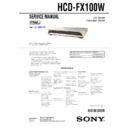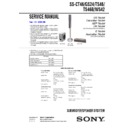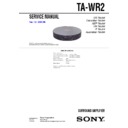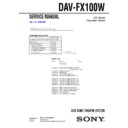Read Sony DAV-FX100W / HCD-FX100W Service Manual online
SERVICE MANUAL
Sony Corporation
Home Audio Division
Published by Sony Engineering Corporation
Published by Sony Engineering Corporation
US Model
Canadian Model
DVD RECEIVER
9-879-685-03
2005L16-1
© 2005.12
© 2005.12
Ver. 1.2 2005.12
HCD-FX100W
HCD-FX100W is the amplifier, DVD/CD
and tuner section in DAV-FX100W.
and tuner section in DAV-FX100W.
— Continued on next page —
SPECIFICATIONS
Model Name Using Similar Mechanism
HCD-FX10
Mechanism Type
CDM69EH-DVBU101
Optical Pick-up Name
KHM-310CAB/C2NP
This system incorporates with Dolby*1 Digital and
Dolby Pro Logic (II) adaptive matrix surround decoder
and the DTS*2 Digital Surround System.
Dolby Pro Logic (II) adaptive matrix surround decoder
and the DTS*2 Digital Surround System.
*1 Manufactured under license from Dolby Laboratories.
“Dolby,” “Pro Logic,” and the double-D symbol are trademarks
of Dolby Laboratories.
of Dolby Laboratories.
*2 Manufactured under license from Digital Theater Systems, Inc.
“DTS” and “DTS Digital Surround” are trademarks of Digital
Theater Systems, Inc.
Theater Systems, Inc.
AUDIO POWER SPECIFICATIONS
POWER OUTPUT AND
TOTAL HARMONIC
DISTORTION:
TOTAL HARMONIC
DISTORTION:
With 3 ohm loads, both
channels driven, from
200 – 20,000 Hz; rated
55 watts per channel
minimum RMS power,
with no more than 0.7 %
total harmonic distortion
from 250 milli watts to
rated output.
channels driven, from
200 – 20,000 Hz; rated
55 watts per channel
minimum RMS power,
with no more than 0.7 %
total harmonic distortion
from 250 milli watts to
rated output.
Amplifier section
Surround mode (reference) music power output
Front: 143 W + 143 W
(with SS-TS46)
Center*: 143 W
(with SS-CT46)
Surround*: 143 W + 143
W
(with SS-TS46B)
Subwoofer*: 285 W
(with SS-WS42)
(with SS-TS46)
Center*: 143 W
(with SS-CT46)
Surround*: 143 W + 143
W
(with SS-TS46B)
Subwoofer*: 285 W
(with SS-WS42)
* Depending on the sound field settings and the source,
there may be no sound output.
Inputs (Analog)
VIDEO 1, VIDEO 2
VIDEO 1, VIDEO 2
Sensitivity: 450 mV
Impedance: 50 kilohms
Impedance: 50 kilohms
Inputs (Digital)
VIDEO 1 (Coaxial)
VIDEO 1 (Coaxial)
Impedance: 75 ohms
VIDEO 2 (Optical)
Phones
Accepts low-and high-
impedance headphones.
impedance headphones.
Super Audio CD/DVD system
Laser
Semiconductor
laser
(Super Audio CD/DVD:
= 650 nm)
(CD: = 790 nm)
Emission duration:
continuous
= 650 nm)
(CD: = 790 nm)
Emission duration:
continuous
Signal format system
NTSC
Frequency response (at 2 CH STEREO mode)
DVD (PCM): 2 Hz to 22
kHz (
kHz (
±1.0 dB)
CD: 2 Hz to 20 kHz (
±1.0
dB)
λ
λ
Tuner section
System
PLL quartz-locked digital
synthesizer system
synthesizer system
FM tuner section
Tuning range
Tuning range
87.5 – 108.0 MHz
(100 kHz step)
(100 kHz step)
Antenna (aerial)
FM wire antenna (aerial)
Antenna (aerial) terminals 75 ohms, unbalanced
Intermediate frequency
Intermediate frequency
10.7 MHz
AM tuner section
Tuning range
Tuning range
530 – 1,710 kHz (with the
interval set at 10 kHz)
531 – 1,710 kHz (with the
interval set at 9 kHz)
interval set at 10 kHz)
531 – 1,710 kHz (with the
interval set at 9 kHz)
Antenna (aerial)
AM loop antenna (aerial)
Intermediate frequency
450 kHz
2
HCD-FX100W
SAFETY CHECK-OUT
After correcting the original service problem, perform the following
safety check before releasing the set to the customer:
Check the antenna terminals, metal trim, “metallized” knobs, screws,
and all other exposed metal parts for AC leakage.
Check leakage as described below.
safety check before releasing the set to the customer:
Check the antenna terminals, metal trim, “metallized” knobs, screws,
and all other exposed metal parts for AC leakage.
Check leakage as described below.
LEAKAGE TEST
The AC leakage from any exposed metal part to earth ground and
from all exposed metal parts to any exposed metal part having a
return to chassis, must not exceed 0.5 mA (500 microamperes.).
Leakage current can be measured by any one of three methods.
from all exposed metal parts to any exposed metal part having a
return to chassis, must not exceed 0.5 mA (500 microamperes.).
Leakage current can be measured by any one of three methods.
1. A commercial leakage tester, such as the Simpson 229 or RCA
WT-540A. Follow the manufacturers’ instructions to use these
instruments.
instruments.
2. A battery-operated AC milliammeter. The Data Precision 245
digital multimeter is suitable for this job.
3. Measuring the voltage drop across a resistor by means of a
VOM or battery-operated AC voltmeter. The “limit” indication
is 0.75 V, so analog meters must have an accurate low-voltage
scale. The Simpson 250 and Sanwa SH-63Trd are examples
of a passive VOM that is suitable. Nearly all battery operated
digital multimeters that have a 2 V AC range are suitable. (See
Fig. A)
is 0.75 V, so analog meters must have an accurate low-voltage
scale. The Simpson 250 and Sanwa SH-63Trd are examples
of a passive VOM that is suitable. Nearly all battery operated
digital multimeters that have a 2 V AC range are suitable. (See
Fig. A)
Fig. A.
Using an AC voltmeter to check AC leakage.
1.5 k
Ω
0.15
µ
F
AC
voltmeter
(0.75 V)
voltmeter
(0.75 V)
To Exposed Metal
Parts on Set
Parts on Set
Earth Ground
SAFETY-RELATED COMPONENT WARNING!!
COMPONENTS IDENTIFIED BY MARK
0
OR DOTTED LINE
WITH MARK
0
ON THE SCHEMATIC DIAGRAMS AND IN
THE PARTS LIST ARE CRITICAL TO SAFE OPERATION.
REPLACE THESE COMPONENTS WITH SONY PARTS WHOSE
PART NUMBERS APPEAR AS SHOWN IN THIS MANUAL OR
IN SUPPLEMENTS PUBLISHED BY SONY.
REPLACE THESE COMPONENTS WITH SONY PARTS WHOSE
PART NUMBERS APPEAR AS SHOWN IN THIS MANUAL OR
IN SUPPLEMENTS PUBLISHED BY SONY.
ATTENTION AU COMPOSANT AYANT RAPPORT
À LA SÉCURITÉ!
LES COMPOSANTS IDENTIFIÉS PAR UNE MARQUE
0
SUR
LES DIAGRAMMES SCHÉMATIQUES ET LA LISTE DES
PIÈCES SONT CRITIQUES POUR LA SÉCURITÉ DE
FONCTIONNEMENT. NE REMPLACER CES COM- POSANTS
QUE PAR DES PIÈCES SONY DONT LES NUMÉROS SONT
DONNÉS DANS CE MANUEL OU DANS LES SUPPLÉMENTS
PUBLIÉS PAR SONY.
PIÈCES SONT CRITIQUES POUR LA SÉCURITÉ DE
FONCTIONNEMENT. NE REMPLACER CES COM- POSANTS
QUE PAR DES PIÈCES SONY DONT LES NUMÉROS SONT
DONNÉS DANS CE MANUEL OU DANS LES SUPPLÉMENTS
PUBLIÉS PAR SONY.
Video section
Outputs
Video: 1 Vp-p 75 ohms
S video:
Y: 1 Vp-p 75 ohms
C: 0.286 Vp-p 75 ohms
COMPONENT:
Y: 1 Vp-p 75 ohms
S video:
Y: 1 Vp-p 75 ohms
C: 0.286 Vp-p 75 ohms
COMPONENT:
Y: 1 Vp-p 75 ohms
P
B
/C
B
, P
R
/C
R
: 0.7 Vp-p
75 ohms
HDMI OUT: Type A (19
pin)
pin)
Input
VIDEO1, VIDEO2: 1 Vp-
p 75 ohms
p 75 ohms
General
Power requirements
120 V AC, 60 Hz
Power consumption
On: 130 W
Standby: 0.3 W (at the
Power Saving Mode)
Standby: 0.3 W (at the
Power Saving Mode)
Dimensions (approx.)
445 70 375 mm
(17
(17
5
/
8
2
7
/
8
14
7
/
8
inches) (w/h/d) incl.
projecting parts
projecting parts
Mass (approx.)
5.1 kg (11 lb 4 oz)
Design and specifications are subject to change
without notice.
without notice.
×
×
×
×
3
HCD-FX100W
CAUTION
Use of controls or adjustments or performance of procedures
other than those specified herein may result in hazardous radiation
exposure.
other than those specified herein may result in hazardous radiation
exposure.
UNLEADED SOLDER
Boards requiring use of unleaded solder are printed with the lead-
free mark (LF) indicating the solder contains no lead.
(Caution: Some printed circuit boards may not come printed with
free mark (LF) indicating the solder contains no lead.
(Caution: Some printed circuit boards may not come printed with
the lead free mark due to their particular size)
: LEAD FREE MARK
Unleaded solder has the following characteristics.
• Unleaded solder melts at a temperature about 40 °C higher
than ordinary solder.
Ordinary soldering irons can be used but the iron tip has to be
applied to the solder joint for a slightly longer time.
Soldering irons using a temperature regulator should be set to
about 350
Ordinary soldering irons can be used but the iron tip has to be
applied to the solder joint for a slightly longer time.
Soldering irons using a temperature regulator should be set to
about 350
°C.
Caution: The printed pattern (copper foil) may peel away if
the heated tip is applied for too long, so be careful!
• Strong viscosity
Unleaded solder is more viscou-s (sticky, less prone to flow)
than ordinary solder so use caution not to let solder bridges
occur such as on IC pins, etc.
than ordinary solder so use caution not to let solder bridges
occur such as on IC pins, etc.
• Usable with ordinary solder
It is best to use only unleaded solder but unleaded solder may
also be added to ordinary solder.
also be added to ordinary solder.
Notes on chip component replacement
• Never reuse a disconnected chip component.
• Notice that the minus side of a tantalum capacitor may be
damaged by heat.
Flexible Circuit Board Repairing
• Keep the temperature of the soldering iron around 270 °C
during repairing.
• Do not touch the soldering iron on the same conductor of the
circuit board (within 3 times).
• Be careful not to apply force on the conductor when soldering
or unsoldering.
Laser component in this product is capable of emitting radiation
exceeding the limit for Class 1.
exceeding the limit for Class 1.
This appliance is classified as
a CLASS 1 LASER product.
The CLASS 1 LASER
PRODUCT MARKING is
located on the bottom exterior.
a CLASS 1 LASER product.
The CLASS 1 LASER
PRODUCT MARKING is
located on the bottom exterior.
4
HCD-FX100W
TABLE OF CONTENTS
1.
SERVICING NOTE
...................................................
5
2.
GENERAL
...................................................................
6
3.
DISASSEMBLY
3-1.
Disassembly Flow ...........................................................
8
3-2.
Top Panel Sub Assy .........................................................
9
3-3.
Front Panel Assy .............................................................. 10
3-4.
I/O Board, DC Fan .......................................................... 10
3-5.
MIB01 Board, MIB01 POWER Board ........................... 11
3-6.
DMB10 Board, TX Board ............................................... 12
3-7.
MAIN Board, H/P Board ................................................. 13
3-8.
FL Board, KEY Board, LED Board ................................ 13
3-9.
DVD Mechanism Deck (CDM69EH-DVBU101) ........... 14
3-10. Base Unit (DVBU101) .................................................... 14
3-11. Optical Pick-up (KHM-310CAB/C2NP) ........................ 15
3-12. SW Board, Bracket (Top) Assy ....................................... 15
3-13. RELAY Board ................................................................. 16
3-14. Motor (Stocker) Assy (Stocker)(M761) .......................... 16
3-15. Motor (Roller) Assy (Roller)(M781) ............................... 17
3-16. Motor (Mode) Assy (Mode)(M771) ................................ 17
3-17. Rubber Roller (Slider) ASSY .......................................... 18
3-18. Timing Belt (Front/Rear) ................................................. 18
3-19. Cam (Gear) ...................................................................... 19
3-20. SENSOR Board ............................................................... 19
3-11. Optical Pick-up (KHM-310CAB/C2NP) ........................ 15
3-12. SW Board, Bracket (Top) Assy ....................................... 15
3-13. RELAY Board ................................................................. 16
3-14. Motor (Stocker) Assy (Stocker)(M761) .......................... 16
3-15. Motor (Roller) Assy (Roller)(M781) ............................... 17
3-16. Motor (Mode) Assy (Mode)(M771) ................................ 17
3-17. Rubber Roller (Slider) ASSY .......................................... 18
3-18. Timing Belt (Front/Rear) ................................................. 18
3-19. Cam (Gear) ...................................................................... 19
3-20. SENSOR Board ............................................................... 19
4.
ASSEMBLY
4-1.
How To Install The Cam (Eject Lock) ............................ 20
4-2.
How To Install The Cam (Gear) ...................................... 20
4-3.
How To Install The Gear (Mode C) ................................. 21
4-4.
How To Install The Gear (Mode Cam) ............................ 21
4-5.
How To Install The Rotary Encorder (S702),
Gear (Stocker Communication) ....................................... 22
Gear (Stocker Communication) ....................................... 22
4-6.
How To Install The Stocker Assy .................................... 22
5.
TEST MODE
............................................................... 23
6.
ELECTRICAL ADJUSTMENT
............................ 27
7.
DIAGRAMS
7-1.
Block Diagram – RF Section– ........................................ 30
– MIB Section – .............................................................. 31
– VIDEO Section – .......................................................... 32
– AMP Section – .............................................................. 33
– AUDIO Section – .......................................................... 34
– MAIN Section – ........................................................... 35
– DIAT TRANSMIT Section – ....................................... 36
– MIB Section – .............................................................. 31
– VIDEO Section – .......................................................... 32
– AMP Section – .............................................................. 33
– AUDIO Section – .......................................................... 34
– MAIN Section – ........................................................... 35
– DIAT TRANSMIT Section – ....................................... 36
7-2.
Printed Wiring Board – CHANGER Section – ............... 37
7-3.
Schematic Diagram – CHANGER Section – ................. 38
7-4.
Printed Wiring Board – DMB10 Section (Side A) – ...... 39
7-5.
Printed Wiring Board – DMB10 Section (Side B) – ...... 40
7-6.
Schematic Diagram – DMB10 Section (1/4) – .............. 41
7-7.
Schematic Diagram – DMB10 Section (2/4) – .............. 42
7-8.
Schematic Diagram – DMB10 Section (3/4) – .............. 43
7-9.
Schematic Diagram – DMB10 Section (4/4) – .............. 44
7-10. Printed Wiring Board – MAIN Section (Side A) – ......... 45
7-11. Printed Wiring Board – MAIN Section (Side B) – ......... 46
7-12. Schematic Diagram – MAIN Section (1/8) – ................. 47
7-13. Schematic Diagram – MAIN Section (2/8) – ................. 48
7-14. Schematic Diagram – MAIN Section (3/8) – ................. 49
7-15. Schematic Diagram – MAIN Section (4/8) – ................. 50
7-16. Schematic Diagram – MAIN Section (5/8) – ................. 51
7-17. Schematic Diagram – MAIN Section (6/8) – ................. 52
7-18. Schematic Diagram – MAIN Section (7/8) – ................. 53
7-19. Schematic Diagram – MAIN Section (8/8) – ................. 54
7-20. Printed Wiring Board – FL/KEY Section – ..................... 55
7-21. Schematic Diagram – FL/KEY Section – ...................... 56
7-22. Printed Wiring Board – LED / H/P Section – ................. 57
7-23. Schematic Diagram – LED / H/P Section – ................... 58
7-24. Printed Wiring Board – I/O Section (Side A) – ............... 59
7-25. Printed Wiring Board – I/O Section (Side B) – ............... 60
7-26. Schematic Diagram – I/O Section – ............................... 61
7-27. Printed Wiring Board – MIB01 Section (Side A) – ......... 62
7-28. Printed Wiring Board – MIB01 Section (Side B) – ......... 63
7-29. Schematic Diagram – MIB01 Section (1/3) – ................ 64
7-30. Schematic Diagram – MIB01 Section (2/3) – ................ 65
7-31. Schematic Diagram – MIB01 Section (3/3) – ................ 66
7-32. Printed Wiring Board – MIB01 POWER Section – ........ 67
7-33. Schematic Diagram – MIB01 POWER Section – .......... 67
7-34. Printed Wiring Board – TX Section – ............................. 68
7-35. Schematic Diagram – TX Section – ............................... 69
7-11. Printed Wiring Board – MAIN Section (Side B) – ......... 46
7-12. Schematic Diagram – MAIN Section (1/8) – ................. 47
7-13. Schematic Diagram – MAIN Section (2/8) – ................. 48
7-14. Schematic Diagram – MAIN Section (3/8) – ................. 49
7-15. Schematic Diagram – MAIN Section (4/8) – ................. 50
7-16. Schematic Diagram – MAIN Section (5/8) – ................. 51
7-17. Schematic Diagram – MAIN Section (6/8) – ................. 52
7-18. Schematic Diagram – MAIN Section (7/8) – ................. 53
7-19. Schematic Diagram – MAIN Section (8/8) – ................. 54
7-20. Printed Wiring Board – FL/KEY Section – ..................... 55
7-21. Schematic Diagram – FL/KEY Section – ...................... 56
7-22. Printed Wiring Board – LED / H/P Section – ................. 57
7-23. Schematic Diagram – LED / H/P Section – ................... 58
7-24. Printed Wiring Board – I/O Section (Side A) – ............... 59
7-25. Printed Wiring Board – I/O Section (Side B) – ............... 60
7-26. Schematic Diagram – I/O Section – ............................... 61
7-27. Printed Wiring Board – MIB01 Section (Side A) – ......... 62
7-28. Printed Wiring Board – MIB01 Section (Side B) – ......... 63
7-29. Schematic Diagram – MIB01 Section (1/3) – ................ 64
7-30. Schematic Diagram – MIB01 Section (2/3) – ................ 65
7-31. Schematic Diagram – MIB01 Section (3/3) – ................ 66
7-32. Printed Wiring Board – MIB01 POWER Section – ........ 67
7-33. Schematic Diagram – MIB01 POWER Section – .......... 67
7-34. Printed Wiring Board – TX Section – ............................. 68
7-35. Schematic Diagram – TX Section – ............................... 69
8.
EXPLODED VIEWS
8-1.
Overall Section ................................................................ 90
8-2.
Front Panel Assy Section ................................................. 91
8-3.
Chassis Section-1 ............................................................ 92
8-4.
Chassis Section-2 ............................................................ 93
8-5.
DVD Mechanism Deck Section-1
(CDM69EH-DVBU101) ................................................. 94
(CDM69EH-DVBU101) ................................................. 94
8-6.
DVD Mechanism Deck Section-2
(CDM69EH-DVBU101) ................................................. 95
(CDM69EH-DVBU101) ................................................. 95
8-7.
DVD Mechanism Deck Section-3
(CDM69EH-DVBU101) ................................................. 96
(CDM69EH-DVBU101) ................................................. 96
8-8.
DVD Mechanism Deck Section-4
(CDM69EH-DVBU101) ................................................. 97
(CDM69EH-DVBU101) ................................................. 97
8-9.
DVD Mechanism Deck Section-5
(CDM69EH-DVBU101) ................................................. 98
(CDM69EH-DVBU101) ................................................. 98
8-10. DVD Mechanism Deck Section-6
(CDM69EH-DVBU101) ................................................. 99
8-11. Optical Pick-up Section (KHM-310CAB/C2NP) .......... 100
9.
ELECTRICAL PARTS LIST
................................. 101




